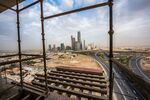Saudi Arabia Rolls Out Expansionary Budget as Economy Stalls
By , , and-
Government pushes back target for balanced budget to 2023
-
Return to growth would help preparations for post-oil era

The King Abdullah financial district in Riyadh.
Photographer: Waseem Obaidi/Bloomberg
Saudi Arabia will boost spending to kick-start growth as the government enters a critical 12 months for its plan to overhaul the economy for the post-oil era.
The kingdom plans to increase spending by more than 13 percent to 1.1 trillion riyals ($293 billion), according to the Finance Ministry. That includes 83 billion riyals from the sovereign wealth fund and 50 billion riyals from national development funds, in addition to the 978 billion riyals allocated in the 2018 budget. The government sees the budget deficit shrinking to 195 billion riyals from 230 billion riyals.
Non-oil revenue is expected to rise to 291 billion riyals from 256 billion riyals, and total receipts up 12.5 percent to 783 billion riyals, according to the ministry’s figures.
“This budget will continue spending on various development sectors in all regions of the kingdom,” King Salman said in a speech. The measures will “propel the economy forward and create more job opportunities for citizens.”
Crown Prince Mohammed bin Salman’s long-term vision to reduce Saudi Arabia’s oil dependence was prompted by the need to rebuild state coffers. But two years of rapid policy changes, including subsidy cuts and new taxes, have left Saudi businesses reeling and contributed to a contraction this year. A return to growth would make it easier to push the prince’s so-called Vision 2030 blueprint forward; plans for 2018 include the introduction of value-added taxation and selling a stake in state-run oil giant Aramco to help create the world’s largest sovereign wealth fund.
MSCI Inc. has also added the kingdom to its watch list for inclusion in its emerging markets index.
‘Determined’
Officials have already slowed the pace for removing subsidies to try to offset the impact of austerity measures on the struggling economy, heeding the advice of the International Monetary Fund to avoid crippling growth. The government said on Tuesday it would push back the target for a balanced budget to 2023 from as early as 2019.
“As expected, the Saudi budget story is one of balancing fiscal consolidation with the need for reviving growth,” said Bilal Khan, a senior economist at Standard Chartered Plc based in Karachi. “Although the spending increase itself may not appear large, on balance, a slower pace of deficit reduction is positive for the 2018 economic outlook.”
Last week, the government announced a 72 billion-riyal stimulus package to be spent over the next few years, part of a broader 200 billion-riyal program unveiled last year. The Ministry of Labor and Social Development has also announced the details of a cash transfer program, known as the Citizen’s Account, to compensate low- and middle-income Saudis for the changes.
Even so, a raft of austerity measures expected in the first quarter will put pressure on households and firms, including higher fuel and electricity prices, a 5 percent value-added tax and a new fee companies will have to pay to employ foreign workers.
— With assistance by Archana Narayanan